قراءة كتاب The History of Insects
تنويه: تعرض هنا نبذة من اول ١٠ صفحات فقط من الكتاب الالكتروني، لقراءة الكتاب كاملا اضغط على الزر “اشتر الآن"
Mite, Chego, and Deathwatch" tag="{http://www.w3.org/1999/xhtml}img"/>
There are many species of mites, beside the itch animal and mite above: to the naked eye, they appear like moving particles of dust: but the microscope discovers them to be perfect animals, having as regular a figure, and performing all the functions of life as perfectly as creatures that exceed them many times in bulk: their eggs are so small that a regular computation shews that 90 millions of them are not so large as a common Pigeon's egg.
The Chego is a very small animal, about one fourth the size of a common flea: it is very troublesome, in warm climates, to the poor blacks, such as go barefoot, and the slovenly: it penetrates the skin, under which it lays a bunch of eggs, which swell to the bigness of a small pea.
The Deathwatch, of which there are two kinds, is an insect famous for a ticking noise, like a watch, which superstitious people take for a presage of death, in the family where it is heard.
SCORPION.
This is one of the largest of the insect tribe. It is met with in different countries, and of various sizes, from two or three inches to nearly a foot in length: it somewhat resembles a lobster, and casts its skin, as the lobster does its shell.
Scorpions are common in hot countries: they are very bold and watchful: when any thing approaches, they erect their tails, and stand ready to inflict the direful sting. In some parts of Italy and France, they are among the greatest pests that plague mankind: they are very numerous, and are most common in old houses, in dry or decayed walls, and among furniture, insomuch that it is attended with, much danger to remove the same: their sting is generally a very deadly poison, though not in all cases, owing to a difference of malignity of different animals, or some other cause.
In the time of the children of Israel, scorpions were a plague in Egypt and Canaan, as appears by the sacred writings. See Deuteronomy, viii. 15, and other passages.
ANTS.
'Who can observe the faithful ant,
And not provide for future want.'
These little animals have been for ages considered as patterns of industry: they were specially noticed by the wise king Solomon. He says, "go to the ant, thou sluggard, consider her ways, and be wise." The ant lays eggs in the manner of common flies; from these eggs are hatched small maggots, or worms without legs; these, after a short time, change into large white aureliae, or chrysales, which are usually called ant's eggs. When a nest of these creatures is disturbed, however great their own danger, the care they take of their offspring is remarkable: each takes in its foreceps, a young one, often larger than itself and carries it off.
These little insects form to themselves, with much industry and application, of earth, sticks, leaves, &c. little hillocks, called ant-hills, in the form of a cone: in these, they dwell, breed, and deposite their stores: they are commonly built in woody places: the brushy plains on Long-Island abound with them: they are from one to two feet in height.





